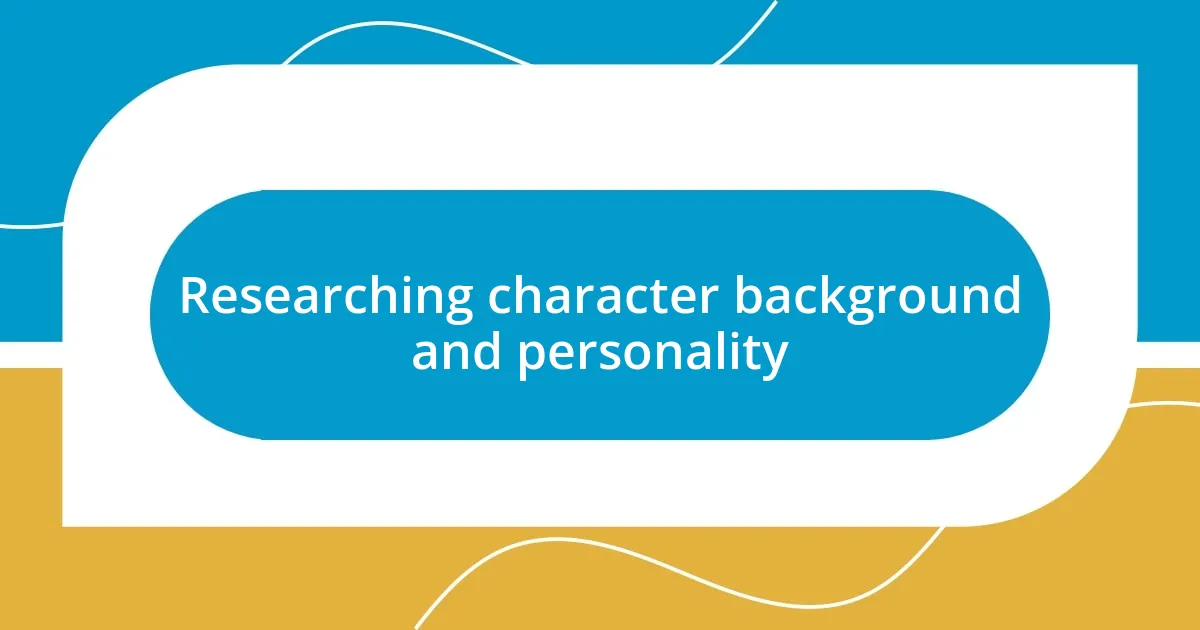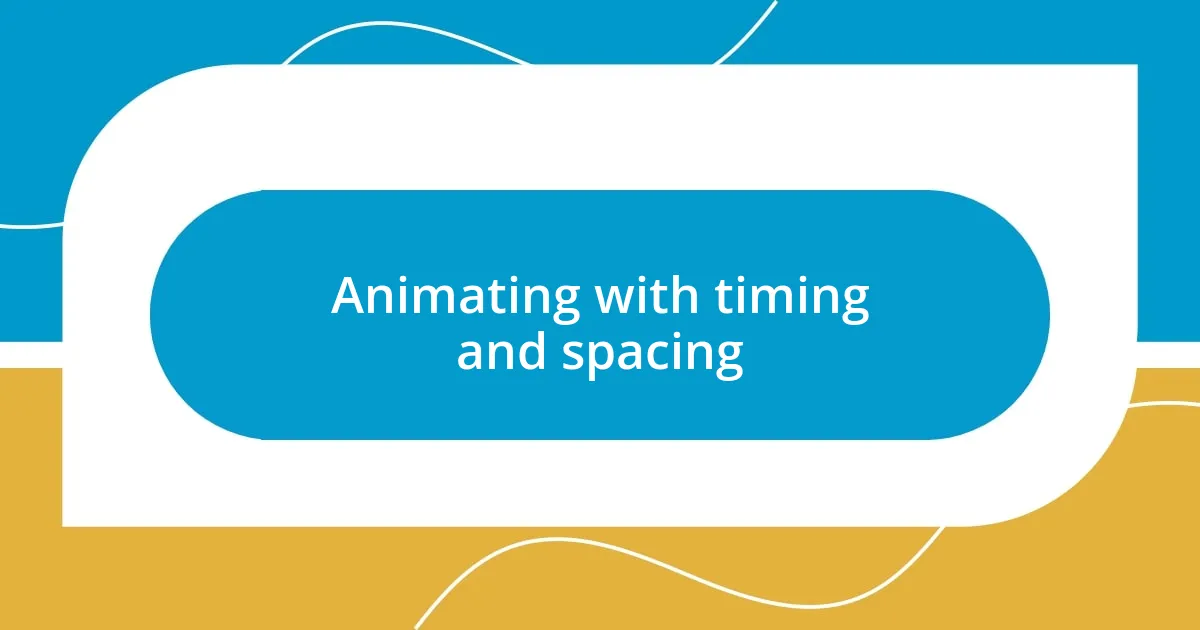Key takeaways:
- Understanding animation principles like squash, stretch, timing, and anticipation is crucial to bring characters to life and enhance emotional storytelling.
- Researching a character’s background and personality informs their movements and emotional responses, allowing for relatable and authentic animations.
- Creating a character animation brief outlines objectives, emotional states, and context, which ensures animations resonate with the audience.
- Reviewing animations from the audience’s perspective and incorporating feedback helps refine movements and emotional accuracy, enhancing overall effectiveness.

Understanding character animation principles
When I first delved into character animation, understanding the principles felt like unlocking a hidden language. The classic principles, such as squash and stretch, played a fundamental role in bringing my characters to life. Have you ever noticed how a character’s movement changes when you add a little bounce? That’s the magic of exaggeration at work!
Another key principle that truly resonated with me is timing. I vividly remember a project where I painstakingly adjusted a character’s decisions to match the pacing of the soundtrack. It was amazing to see how just a fraction of a second could transform a clumsy dance into a captivating performance. Have you ever felt the difference in energy between a slow, dramatic moment and a quick, comedic one? That’s timing at its best!
Finally, anticipation is a principle that can set the stage for any action. Once, while animating a character preparing to leap, I realized the importance of showing a wind-up to build excitement. It’s like when you watch an athlete before they make a great play—there’s a buildup that makes the moment even more thrilling. Isn’t it fascinating how our own imprints of anticipation can shape the emotional journey we want our audience to experience?

Researching character background and personality
Researching a character’s background and personality greatly influences how I approach their animation. Understanding where a character comes from helps me decide how they might move or respond to different situations. I remember a project involving a timid character. Learning about their upbringing shaped not just their posture but also their hesitant movements. It’s incredible how a rich backstory can add layers of depth to the animation process.
When I think about personality traits, I often find myself relating to characters on a personal level. For instance, animating a boisterous character became a cathartic experience for me—they reminded me of my exuberant uncle. Infusing that zest into their animation made it feel more authentic and relatable. I often wonder, have you ever experienced that connection where a character’s quirks reflect someone you know? It amplifies the emotional resonance and helps the audience connect on a deeper level.
The research phase isn’t just about facts; it’s about diving into emotions and motivations. I recall studying the conflict in a villainous character, which led me to consider their insecurities and regrets. By understanding their complexity, I was able to animate them in a way that portrayed their flaws, making them feel more human. This exploration certainly enriches the storytelling, wouldn’t you say?
| Character Aspect | How it Influences Animation |
|---|---|
| Background | Shapes movements and emotional responses. |
| Personality Traits | Guides gesture style and energy levels. |
| Emotional Journey | Enhances relatability and audience connection. |

Developing a character animation brief
Developing a character animation brief is crucial, as it serves as the foundation for the entire project. When I begin this process, I focus on three key elements: what the character is doing, their goals, and the emotions they experience during those actions. In one of my early projects, I vividly remember sketching out a scenario where a character tried to impress their crush. Just mapping out their desires and fears helped me visualize how every movement conveyed their anxious energy.
Here are the essential components I consider while crafting an animation brief:
- Character’s Objective: What is the character trying to accomplish?
- Physical and Emotional State: How do their feelings influence their movements?
- Setting and Context: Where is the character, and how does the environment affect their actions?
- Target Audience: Who is this character for, and what reactions do I want to evoke?
By thoughtfully aligning these components, I can create not just animations but heartfelt stories that resonate with the viewer. It’s all about bringing that character to life in a way that feels authentic and engaging.

Sketching character poses and movements
When sketching character poses and movements, I find it vital to capture the essence of a character’s personality quickly. I usually start with rough outlines, prioritizing the silhouette and general body language before diving into details. Recently, while working on an animated dog character, I focused on how his excited, wagging tail and hunched posture reflected his playful spirit, which made the sketching process incredibly enjoyable and rewarding.
I often think about how a single pose can tell a story. For example, I once animated a character who was supposed to be anxious about giving a presentation. While sketching, I emphasized their slumped shoulders and fidgety hands, which resonated with my own experiences of stage fright. This not only made the animation feel real but also allowed me to tap into that relatable emotion—after all, haven’t we all felt anxiety at some point?
Translating movements into sketches requires an understanding of weight and flow. I remember experimenting with sketches of a villainous character climbing a staircase; their powerful strides contrasted sharply with the tension of the scene. It felt like a dance where every flourish and stumble captured their ruthless ambition. The thrill of mastering motion on paper is transformative—it’s where I can let my imagination take the lead and shape the character’s journey before the animation begins.

Creating a storyboarding sequence
When I create a storyboarding sequence, I treat it like setting up a stage for a theatrical performance. Each frame becomes a snapshot of the character’s journey, capturing key moments that define their arc. There was a time when I was storyboarding a scene where a young hero was venturing into a dark forest for the first time. I remember how I carefully positioned the camera angles to convey both the character’s bravery and their underlying fear, shaping the emotional tone even before animation began.
I also find that including transitional elements within the storyboard is critical. For instance, in one project, I illustrated a character going from a state of joy to one of despair, using gradual changes in facial expressions and posture. By experimenting with these transitions, I created a stronger narrative flow that not only captured the character’s emotions but kept the audience engaged. Have you ever watched a scene shift abruptly without any cues? It tends to jolt me out of immersion, so I strive to avoid that in my storyboards.
Finally, I believe that the pacing of each sequence matters immensely. In one experience, I storyboarded a comedic scene where timing was everything; I would sketch key frames indicating pauses for laughter. I vividly recall a moment when I realized the importance of silence—allowing the audience to soak in the humor before moving on. It taught me that sometimes, less is more; each pause and beat can elevate the storytelling to another level, creating an unforgettable experience.

Animating with timing and spacing
Timing and spacing are crucial in making character animations feel alive. I remember a project where I animated a cat sneaking up on a bird. I experimented with spacing out the cat’s movements; each slow, deliberate step built tension. It made me realize how the audience can hold their breath in anticipation. Have you ever experienced that moment in animation where the world feels suspended? That’s the power of timing.
In my experience, spacing also communicates a character’s weight and emotion. I once worked on a scene featuring an elderly character slowly reaching for a cup. By exaggerating the spacing between movements, I highlighted their struggle and fragility. I often think about how small adjustments in spacing can reinforce the narrative. It’s fascinating how a slight shift can change the entire feel of a scene.
When it comes to timing, I can’t help but reflect on the importance of rhythm. While animating a joyful character skipping, I played with the timing of each leap. The syncopation—in which some steps felt faster and others slower—mirrored the character’s carefree spirit. It led me to consider: how does rhythm influence our perception of movement? Each animation session becomes a dance, where every frame and pause plays a vital role in storytelling, revealing layers of emotion and intention within the character’s journey.

Reviewing and refining character animations
Reviewing character animations is a moment of great reflection for me. I often step back and immerse myself in the work, watching it from the perspective of the audience. Just the other day, while revisiting an animation I created, I noted how a character’s smile didn’t quite match the warmth of the scene. It made me ponder: how much does emotion in animation translate to the viewer? Small tweaks, like adjusting the curve of that smile, can create a ripple effect on the overall emotion portrayed.
When refining animations, feedback becomes a powerful tool. For instance, in one project, I gathered a few friends to watch my work-in-progress. Their reactions were eye-opening! I observed how they reacted to gestures I thought conveyed confidence, but they saw hesitation instead. It reminded me that sometimes, we’re too close to our work to see it clearly. Ever felt that sting of realization? It pushes me to refine those key moments where clarity and intention matter most, making sure the animation resonates with the audience.
Another important aspect I consider is the flow of movement within the animation. There was a scene where a character was running away, but it felt sluggish. I distinctly remember struggling with it; my instinct was to exaggerate the speed. After some revisions, I opted for smooth, fluid motions instead. Watching the scene evolve taught me that sometimes, refining doesn’t just mean making things faster or flashier. It’s about creating a believable experience that draws viewers in. How can you captivate your audience if the movement feels off? It’s this understanding that shapes my approach to refining animations continuously.














